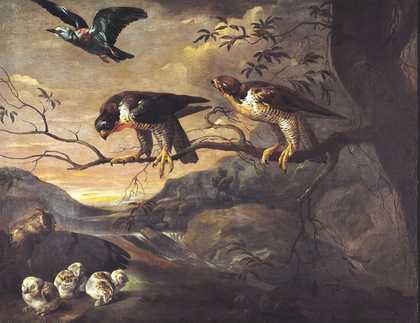
Fig.1
Francis Barlow ?1626‒1704
A Roller, two Peregrine Falcons and a Long-eared Owl with her Young
Date not known
Oil paint on canvas
1060 x 1372 mm
T01402
This painting is in oil paint on canvas measuring 1060 x 1372 mm (fig.1). The canvas is plain woven linen with 11.5 vertical and 15 horizontal threads per square centimetre (fig.2). The weave is uneven with many slubs in both directions. There is strong cusping on the upper and lower edges and weaker on the uprights.1 Diagonal bar marks in the lower left corner suggest that the original stretcher or strainer had corner braces.

Fig.2
X-radiograph of A Roller, two Peregrine Falcons and a Long-eared Owl with her Young
The ground is opaque reddish brown colour (fig.3). It was applied thinly (it is about 40 microns thick), and was scraped hard into the canvas weave. It is composed of gypsum, a range of ochres and umbers, lead white, chalk, black and glassy particles, bound together in oil. Abrasion of the paint during early cleaning of the picture has damaged the ground too, leaving exposed canvas visible on the tops of the threads in many areas.

Fig.3
Detail of a branch painted on top of the sky paint. The heavy canvas weave is visible in reflected light
No preliminary drawing is visible either with the eye or infrared, though some form of preparatory design is likely to be present, as the painting displays no alterations in the composition or complicated overlapping of layers. Another version of the same composition, thought to be of better quality, is known to exist and it is therefore possible that this painting is a copy by Barlow. X-radiography revealed the figure ‘5’ stencilled on the back of the original canvas, suggesting that the painting was part of a set (fig.2).
Cross-sections show a very simple general construction of one wet-in-wet paint layer on top of the reddish brown ground, with details added on top. Generally the artist has worked from dark to light, the final detailing applied using short dashes of lighter, thicker paint creating the slight impasto of the owlets’ down and the bright yellow of the falcons’ clawed feet. Microscopical examination shows that the effect of soft feathers on the underside of the falcons’ breast was achieved by dragging a dry brush through wet paint. The background is carefully painted around the birds using slightly thicker paint with visible brushstrokes, especially in the lighter parts of the sky.
The petrol blue of the roller was mixed from smalt, green earth, black, lead white, brownish yellow lake, chalk and a trace of vermilion.2 The orange feathers on the falcon’s breast were made of mixtures of chalk, lead white, black, brownish orange lake, yellow lake and a trace of vermilion. The tones of the pale green grass were mixed from lead white, verdigris, ochre, smalt, black, lead tin yellow and yellow lake.
The canvas has a twentieth-century, glue-paste lining and a stretcher that appears to be from a similar date. Shallow drying cracks are present in some of the thin dark brown and black glazes. The varnish is slightly yellowed.
January 2004
